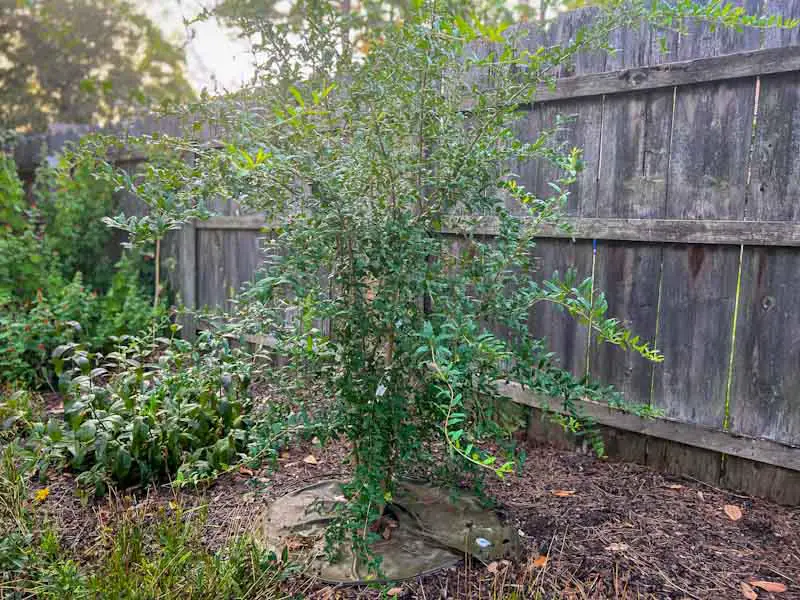
We may receive commissions from purchases made through links in this post, at no additional cost to you.
All of the topics I write about on The Fruit Grove are because of some garden problem I’ve encountered, or a question that came up as I was getting to know a new fruit. My first pomegranate tree left me scratching my head about its lack of fruit and blossoms for a while.
Luckily, the problem was mostly due to my own inexperience with how to care for the tree. As I learned more, I quickly realized there were simple things I could do to help it fruit better. So why might a pomegranate tree not be producing fruit or blossoms, and what can you do about it?
The most common reasons a pomegranate tree may fail to fruit are a lack of pollination, lack of sunlight, cold damage, tree age, or other cultural problems such as pruning or fertilization. Depending on the time of year, each of these issues could also affect whether or not the tree produces blossoms.
As far as my pomegranate tree goes, I admittedly made a few of the mistakes on this list – but have since corrected them! Read on to learn the reasons why a pomegranate tree may fail to blossom or produce fruit…and what to do about it.
1. Wrong Type of Pomegranate Tree
Did you know that not all pomegranate trees are meant to grow actual pomegranates? Some pomegranate varieties are sold only for their ornamental qualities. And they are truly ornamental – small, shiny deep green leaves, bright red-orange tubular flowers that are pollinator magnets, and a pleasant shrubby habit.
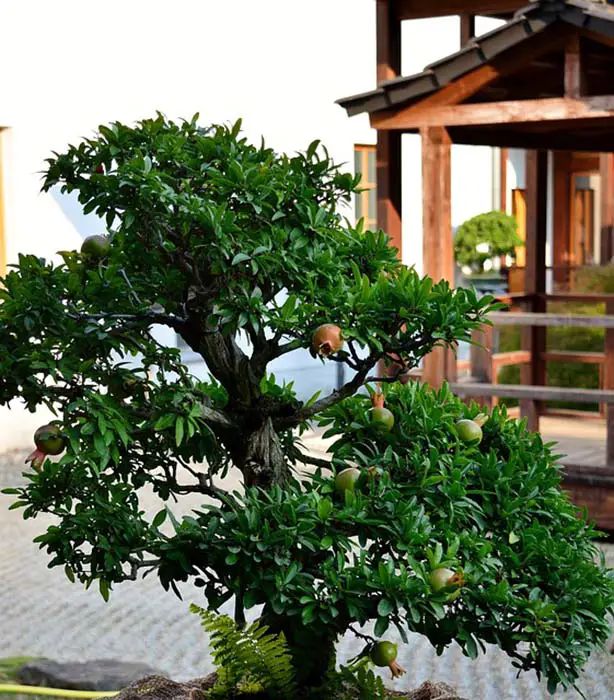
One of these popular ornamental varieties, ‘Nana’ (sometimes just labeled as ‘Dwarf Pomegranate’) is frequently used as a bonsai tree because it naturally grows to only about 3 feet tall. It does produce small edible pomegranates (just 1-2 inches in diameter), but their flavor isn’t very good.
Non-fruiting pomegranates often produce double flowers with numerous petals (a bit like a chrysanthemum), are more compact in size, and show a wider range of blossom colors. Some ornamental pomegranate cultivars include ‘Chico’, ‘Variegata’, ‘Madame Legrelle’, and ‘Alba Plena’.
What to Do About It:
There’s little to do other than replace the decorative pomegranate plant with a fruiting one. The good news is, the fruiting varieties are just as ornamental as the non-fruiting ones. Many fruiting cultivars grow very large, so if space is an issue, plant a more compact variety.
Fruiting pomegranates suitable for smaller spaces or containers include ‘Red Silk’, ‘Angel Red’, and ‘Parfianka’.
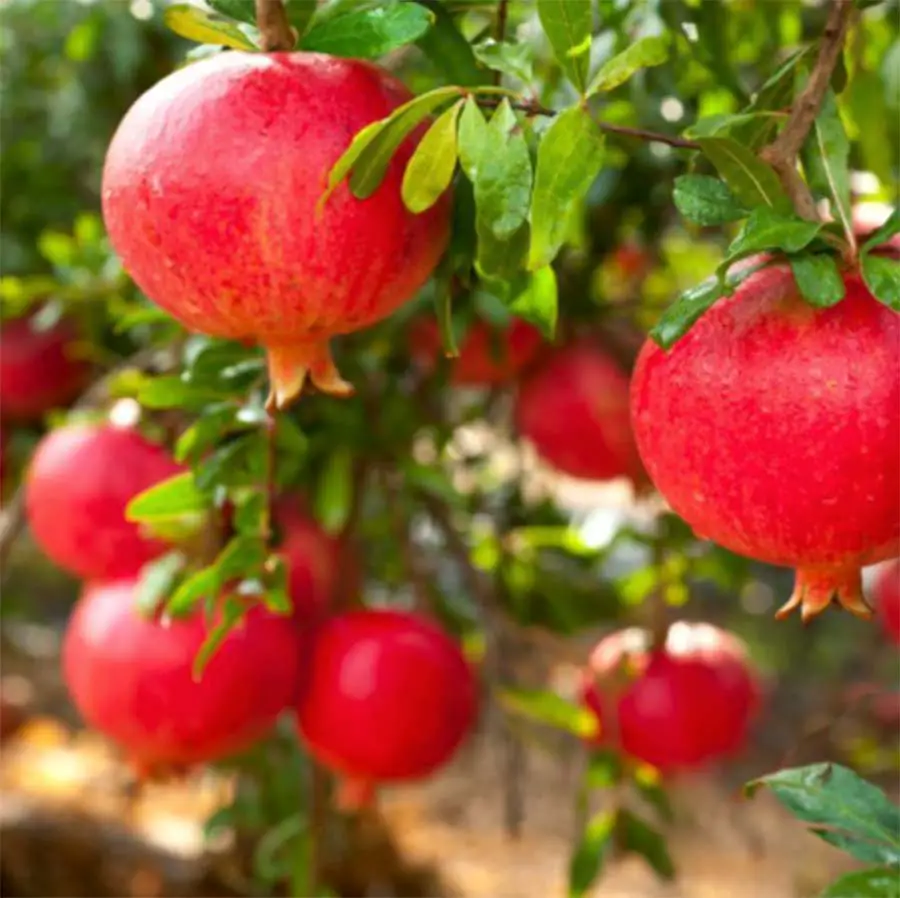
For more delicious pomegranate cultivars to grow at home, check out: Choosing the Perfect Pomegranate Tree (19 Top Varieties)
2. Water Stress
You’ll often see pomegranate trees labeled as “drought-tolerant,” but this can be misleading. They are best suited for Mediterranean-style climates (hot, dry air and cool winters), but pomegranate trees need consistent soil moisture in order to produce fruit.
A pomegranate tree will live through drought conditions, but the first thing it will do is drop its flowers and/or fruit in order to conserve energy. A lack of water puts the tree under stress and into survival mode, rather than fruit-production mode.
Learn more: Parched Pomegranate Tree? How to Water It Well
Something similar happens when a pomegranate tree is over-watered or sitting in soggy soil for too long. They may need consistent moisture, but they must have very well-drained soil.
Saturated soil limits the amount of oxygen available to the roots, which can lead to root rot, fungal disease, and tree death. As you can imagine, the stress of overwatering (particularly in poorly-drained soil) will also cause the tree to drop its blossoms and fruit.
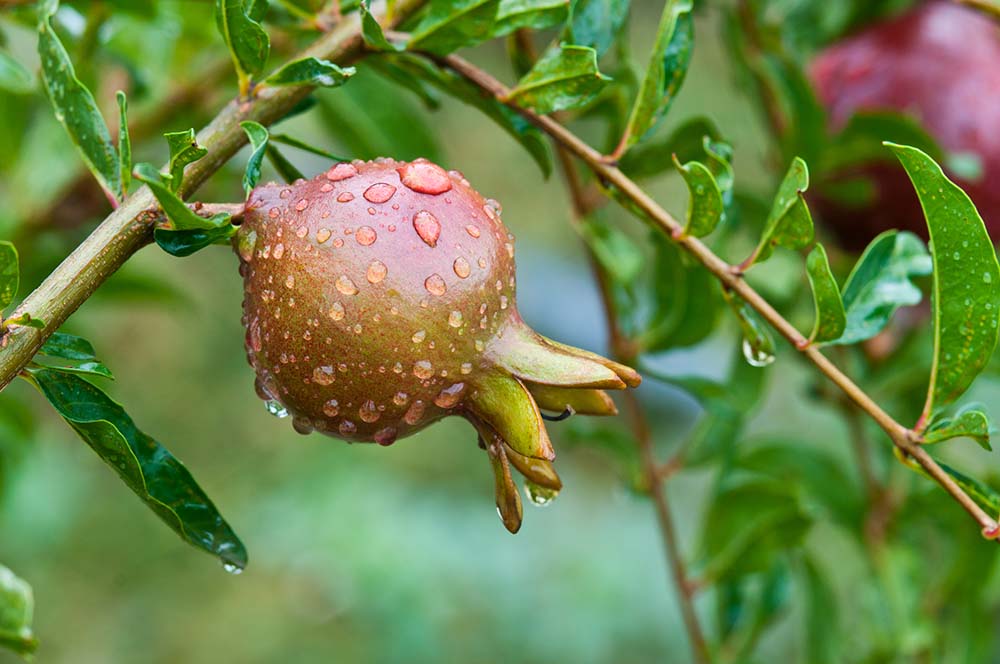
What to Do About It:
Water the tree consistently during flowering and fruiting, about once a week during hot weather, or once every 10-14 days during milder weather. Use a moisture meter (I use this one in my own garden) to see how damp the soil is around the tree. Or, just stick a finger in the soil. If the top 2-3 inches of soil is dry (up to the second knuckle), go ahead and water.
If you are concerned about over-watering or whether your soil is well-drained enough, again use the moisture meter to check the soil’s moisture level. Improving soil drainage around an already planted tree is challenging, but there are a few things you can do to make a difference.
Learn more details about how to fix soil drainage here: Soil Drainage for Fruit Trees
3. Lack of Pollination
Pomegranate trees are self-fertile, so you only need one tree for pollination to occur. However, if your tree blossoms in spring but fails to set fruit, it may be due to a pollination problem.
Pomegranate tree blossoms are fertilized when pollinators (hummingbirds, bees, or other insects) transfer pollen from the male stamen of one flower to the female pistil (or stigma) of another flower. If there aren’t enough pollinators around, or if they are inhibited by weather or other circumstances, then fruit set will suffer.
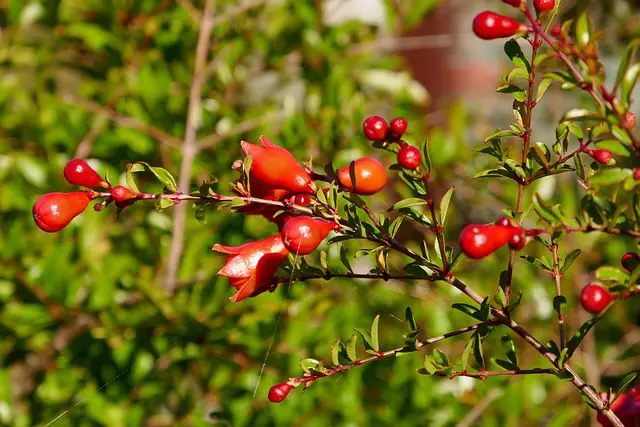
Pomegranate blossoms are “perfect” in that they contain both male and female parts, but each flower has either a dominant stigma or dominant stamens. This means that, although a pomegranate flower can be fertilized by another from the same tree, not all flowers will become fruits.
If you notice a lot of flowers on the ground (but still see plenty on the tree), don’t worry – the tree is probably just dropping the non-fertilized male-dominant blossoms.
Learn more: Perfect Timing: When Does a Pomegranate Tree Bloom and Fruit?
What to Do About It:
Try planting another variety of pomegranate nearby. These trees are self-pollinating, yes, but a second tree will significantly increase the size of the crop (plus you’ll have two trees’ worth of pomegranates instead of one).
Also, make the environment nearby appealing to pollinators. Pomegranate flowers themselves are very attractive to hummingbirds, bees, and other insects, but planting other pollinator-friendly flowers nearby could entice more to come buzzing around. Choose flowers that bloom around the same time as the pomegranate tree (mid-spring), such as lavender, salvia, or chokeberry.
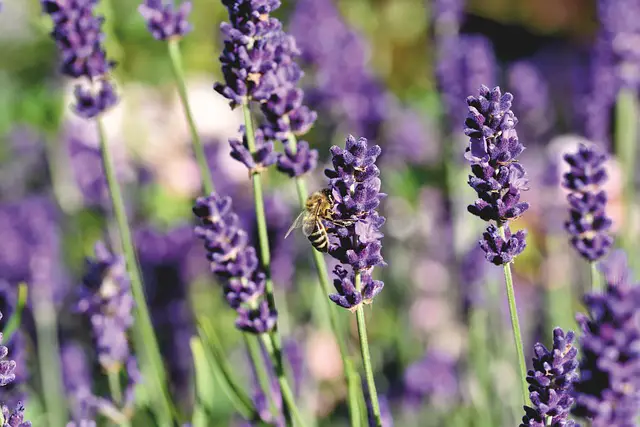
A source of water also helps pollinators. A shallow dish or birdbath filled with water and some stones to land on will keep the pollinators coming to the area.
Avoid harmful pesticides or other sprays, particularly while the blossoms are in full bloom. Even organic sprays such as neem oil or horticultural oils should be sprayed in the early morning or late evening when bees aren’t as active.
As a last resort, try hand-pollination. Carefully swirl a cotton swab or small paintbrush inside a flower to manually pick up some of the bright yellow pollen. Transfer the pollen gently to the long, bulbous stigma of another flower. Be very gentle to avoid damaging the blossoms.
4. Over-fertilization
Pomegranate trees generally do not need much fertilizer, particularly if you have decently fertile, loamy soil (lucky you). Areas with lean, sandy soil (like mine) might need fertilizing once or twice a season.
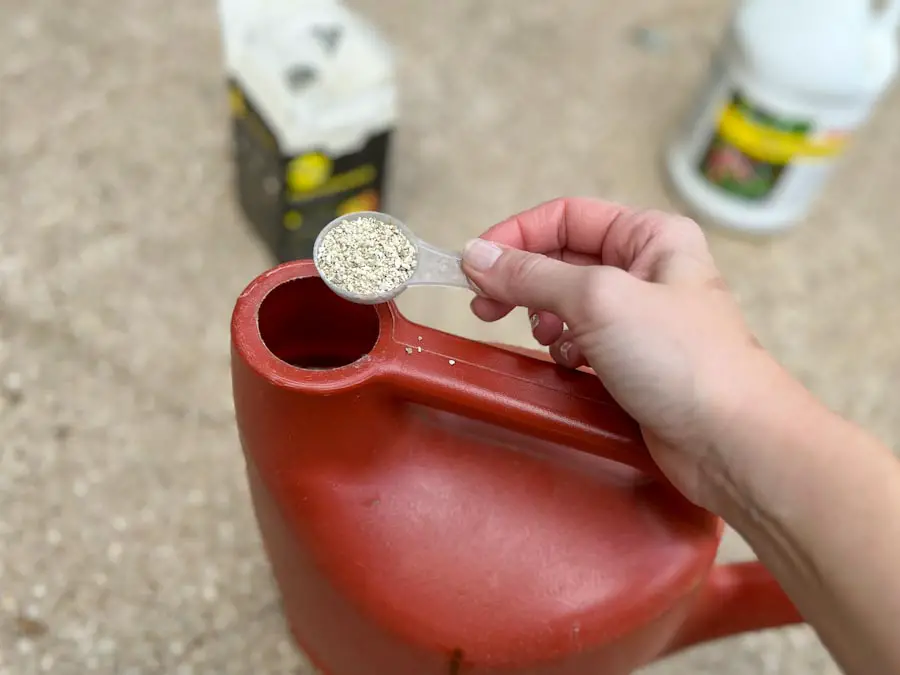
Too much fertilizer – particularly nitrogen-heavy fertilizer – causes the tree to vigorously grow leaves and shoots, but not fruit. Phosphorous and potassium are important elements for fruiting, but pomegranate trees also need a balance of micronutrients, including calcium, boron, and magnesium.
If your pomegranate tree is planted near the lawn, it may be absorbing fertilizer intended for the grass. Tree roots spread out quite far so they can seek out the water and nutrients the tree needs. Lawn fertilizers tend to contain a lot of nitrogen, so a pomegranate tree might become unintentionally over-fertilized.
What to Do About It:
As a rule of thumb, only fertilize pomegranate trees if your soil is very sandy, or if you notice other symptoms of nutrient deficiency (such as yellowing leaves or fruit cracking). Or at most, feed the tree with an organic, fairly balanced NPK fertilizer (such as this 5-4-6 True Organic Fruit & Nut Tree Granular Fertilizer) once in the early spring.
Adding a layer of organic compost is a great way to provide nutrients in a gentle, balanced way. Not only does compost add nutrients, but it also improves overall soil health. If you aren’t sure if you should fertilize, begin by adding composted manure, worm castings, mushroom compost, or homemade or bagged organic compost around your pomegranate tree.
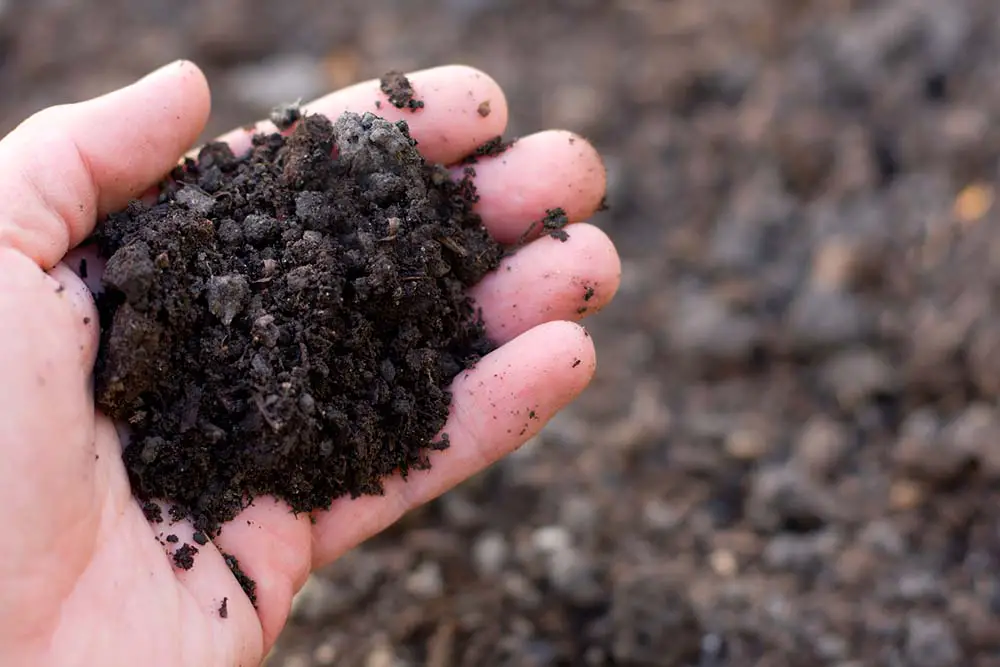
Less is more when it comes to fertilizer. In general, I only feed my fruit trees if I have reason to believe they are lacking in some essential nutrients. A great way to check for basic macronutrient levels is to use an inexpensive soil testing kit like this one.
For a more detailed report on the macro- and micronutrient levels, pH, and levels of organic matter in your soil, I highly recommend a soil testing service such as SoilKit. SoilKit is an easy-to-use, affordable mail-in service, and the results come with specific seasonal recommendations to amend your soil. (I am an affiliate for them, but I only recommend this service because I used it myself, and I was so happy with the results.)
5. Frost Damage
Just like with most fruit trees, pomegranate blossoms and young fruits are sometimes damaged by extreme winter cold or late spring frosts. Pomegranates are decently cold hardy (considering they are sub-tropical or tropical plants) and generally tolerate down to about 10°F. However, parts of the tree may die in sustained temperatures of 15°F or below.
Late spring frosts could harm the tender pomegranate blossoms and baby fruits, causing them to drop prematurely. The flowers might even look undamaged, but the interior structures can be rendered infertile by the cold. Unfortunately, this will reduce or eliminate the pomegranate crop for the entire season.
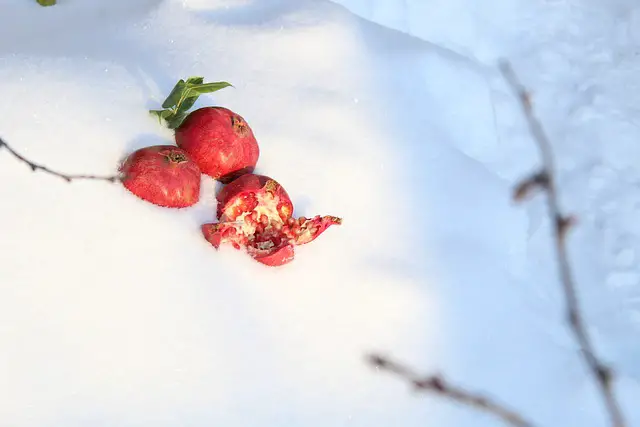
What to Do About It:
If it’s not too late, consider planting a more cold-hardy pomegranate variety. ‘Russian 26’ and ‘Salavatsky’ grow all the way up to USDA zone 7, and could potentially grow even in zone 6 with some winter protection.
A thick layer of organic mulch will help to insulate the roots and protect the tree from winter temperatures. Use a combination of shredded leaves (I keep mine from my fall raking), pine bark, or compost. Even piled-up snow will keep the roots closer to a safe 32°F, rather than dropping far lower in temperature.
When you mulch around your pomegranate tree, leave a few inches of space around the trunk to allow for airflow. Remove or spread out the mulch when the temperatures start to rise in the spring.
6. Pruning Problems
Yearly pruning benefits pomegranate trees in many ways – bigger, better fruit, for one. But if you over-prune, or if you prune at the wrong time of year, it may have an impact on whether or not you see pomegranates on the tree.
Pomegranates produce fruit mainly on new growth, at the ends of branches. If you prune in the late spring or summer while the tree is actively growing, you could potentially remove all of the fruiting growth.
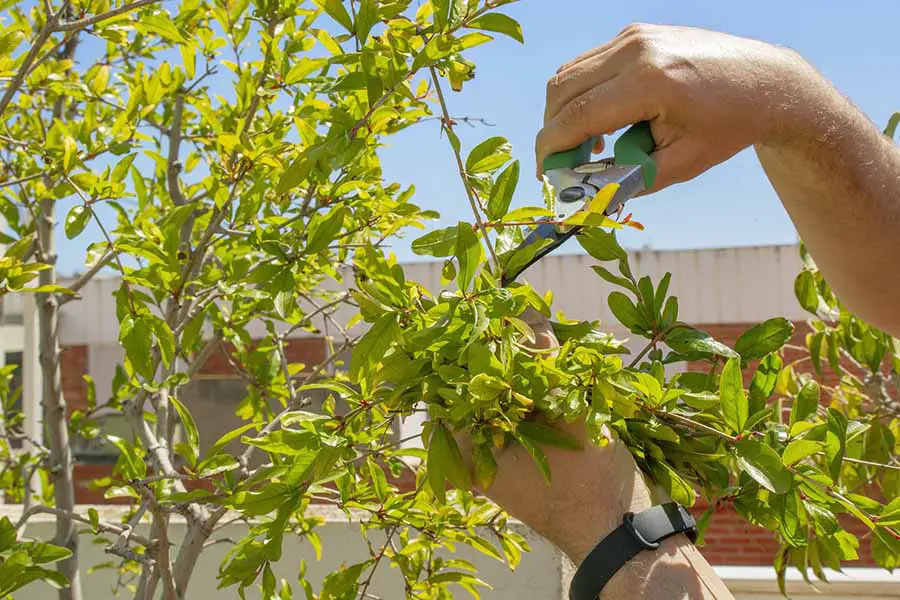
Even if you pruned at the ideal time of year – late winter or early spring while the tree is still dormant – pruning off too much could have the same effect. Cutting the tree back too far will stimulate it to grow again come spring, but the tree will put its energy toward re-establishing a canopy rather than developing fruit.
If you don’t prune at all, pomegranate trees can grow a bit wild. They continually send up new shoots from the base of the plant. All of those shoots mean a bigger canopy for the tree to support. The roots can only uptake a certain amount of nutrients – if all of the nutrients are needed to support the huge shrub, there may not be much left for fruit.
Light pruning every year, including removing excess root suckers, will keep the tree in balance. It may seem counterintuitive, but moderate pruning can actually increase the number (and size) of pomegranates the tree produces.
What to Do About It:
Prune pomegranate trees while the tree is dormant. Wait until the end of winter or very early spring, after your average last frost date, but before bud break. Trim extra root suckers, damaged growth, or inward-growing branches. Shorten the main branches by no more than 1/3 to avoid cutting off too much fruiting wood.
Learn exactly how to prune pomegranate trees here: *pruning article
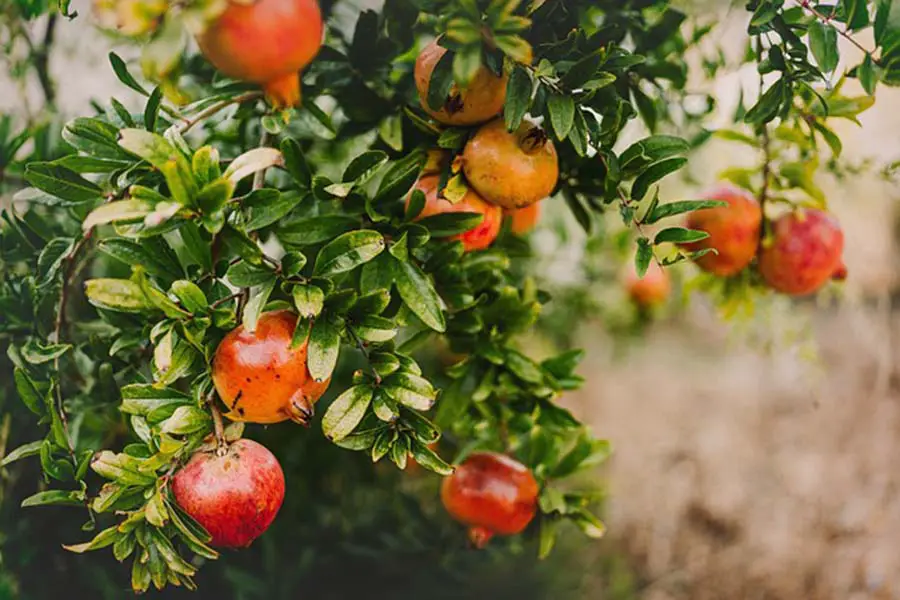
7. Nutrient Deficiency
A pomegranate tree’s lack of fruit is more likely to be from over-fertilizing than a lack of fertilizing, but it’s still worth mentioning here. Nutrient deficiencies, especially of potassium, phosphorus, and calcium, may cause a pomegranate tree to produce less fruit.
Even if the tree does have fruit on it, a lack of calcium and/or boron could cause those fruits to weaken and split open early, making them inedible.
Learn about how to combat pomegranate splitting, including all of the other reasons it can happen, here: Split Pomegranates? Why Splitting Happens and How to Stop It.
Most nutrient deficiencies show signs other than a problem with fruiting, such as stunted growth or yellowing leaves. It’s possible that a nutrient deficiency combined with other problems on this list could contribute to a flowering or fruiting problem.
What to Do About It:
Choose a fertilizer that has higher concentrations of potassium and phosphorus (the second two NPK numbers on the fertilizer bag), as well as other micronutrients. A great option for pomegranate trees is Jobe’s Organics 3-5-5 Fruit & Nut Granular Fertilizer.
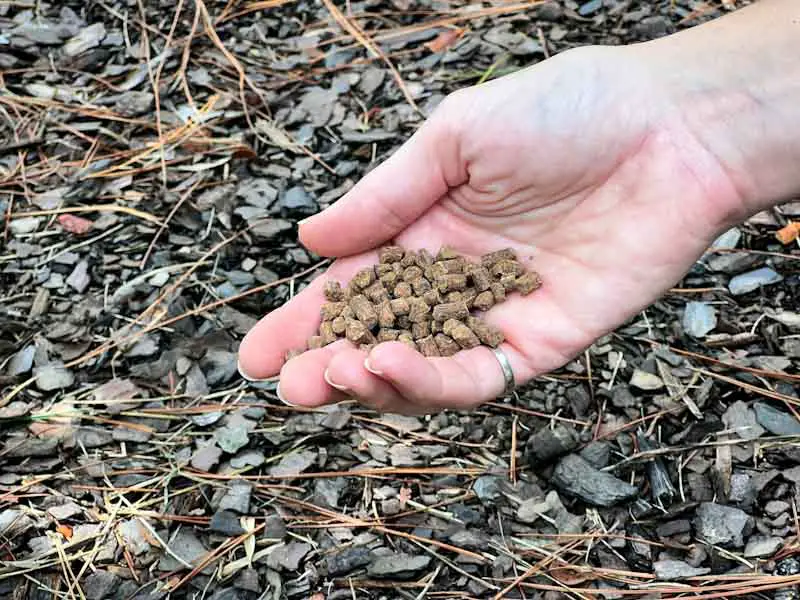
In most cases, fertilize once in the spring at bud break, and again about a month later. Do not fertilize a newly planted pomegranate tree, because its roots are more susceptible to burning. Do not fertilize any later than August – a late season flush of growth might make the tree more susceptible to cold damage once winter hits.
A regular application of compost is a simple way to make sure your pomegranate tree gets what it needs. Compost will improve the soil over time, hopefully leading to fewer fruiting issues.
8. Lack of Sunlight
Pomegranate trees need at least six hours of direct sun per day. Sunlight is, of course, essential for overall growth and tree health, but it also plays an important role in fruiting.
A pomegranate tree that is starved for sunlight may not flower or fruit at all. The tree might produce fruit with less than 6 hours of sun, but chances are it will be a smaller crop, and the resulting fruits will be of lower quality.
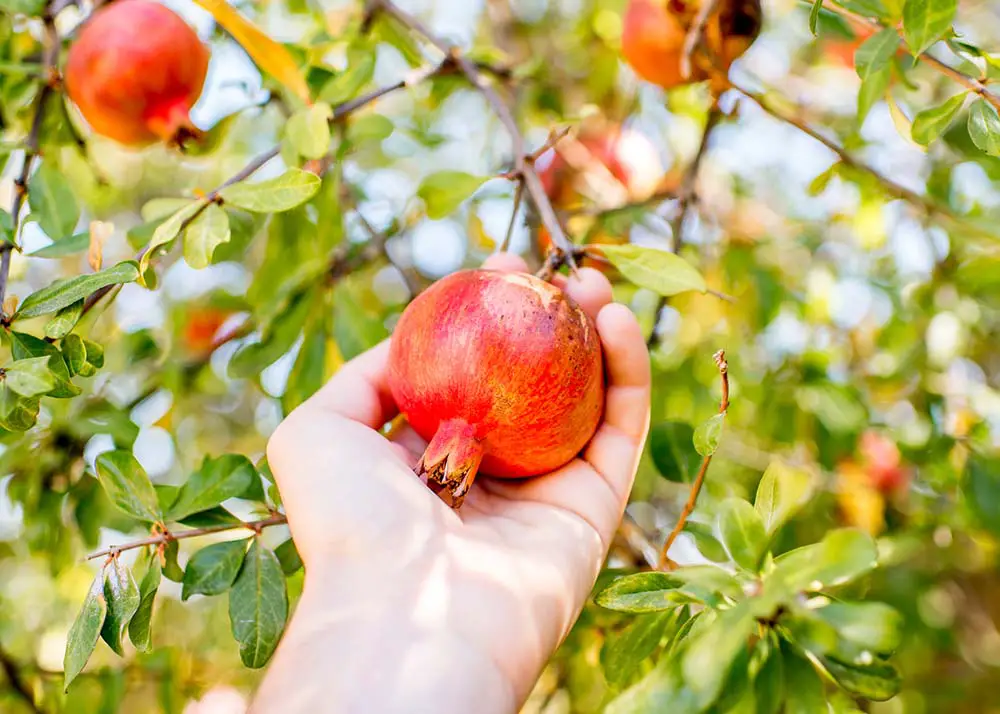
The amount of sunlight is directly related to how much sugar develops in the fruit. Light is necessary for photosynthesis, which is the process of converting light into carbohydrate food for the plant. Those carbohydrates, or sugars, are then stored in the fruits, increasing their sugar content. Other flavor compounds, such as acidity, are also favorably affected by the right amount of light.
Pomegranate trees thrive in bright sunlight and heat – but be careful to water regularly during extremely hot weather. The hotter it is, the more water evaporates from the leaves and the skins of the pomegranates. If that water isn’t replaced, the tree could get stressed and drop the fruit.
What to Do About It:
Ideally, plant a pomegranate tree in a spot that gets at least 6 hours of direct sun per day. Or, grow a pomegranate tree in a pot, which you can then move to follow sun exposure throughout the season.
If you can’t move your tree, keep other plants and trees nearby trimmed so they aren’t blocking any light. Prune the pomegranate tree so that light can penetrate throughout the whole plant. Look for areas of dense growth to thin out, opening up the center of the tree.
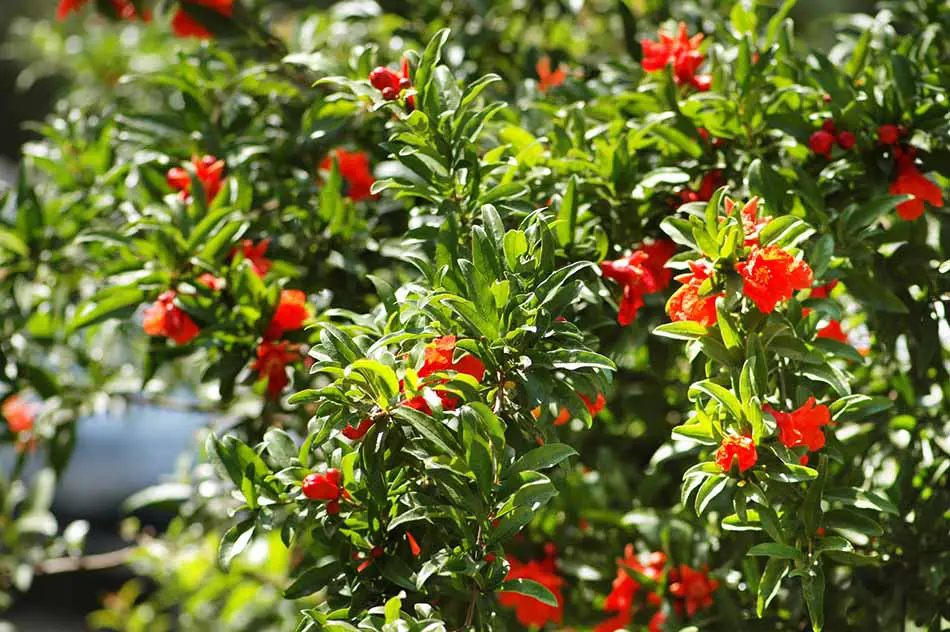
9. Pests and Diseases
Specific diseases and pests don’t really prevent a pomegranate tree from flowering or fruiting, but they could cause early fruit drop or a reduction in crop size. If your problem is that the fruits that are on the tree are damaged or falling early, it might be because of one of the following:
- Fungal diseases (Alternaria or Aspergillis fruit rot, heart rot, mold, anthracnose, Cercospora leaf spot, Phytophthora, and others). Several different fungal infections affect the roots, leaves, shoots, flowers, and/or fruit of pomegranate trees. Fungus will typically show other symptoms such as lesions on the leaves or brown spots on the fruit, all of which ultimately lead to fruit dropping.
- Mealybugs. These tiny insects feed on sap from young leaves and shoots, which can cause the leaves to curl up. You might notice black sooty mold on the tree because of the honeydew secreted by mealybugs (similar to aphids). A persistent infestation can lead to fruit drop.
- Pomegranate fruit borer. Borer insects do exactly what it sounds like – bore holes into fruit and branches. You’ll notice obvious holes in the fruit, which could lead to rotting and fruit drop.
What to Do About It:
Watch for signs of infestation or infection. The best way to prevent pest and disease problems is with good cultural care: site selection, soil, watering habits, and pruning.
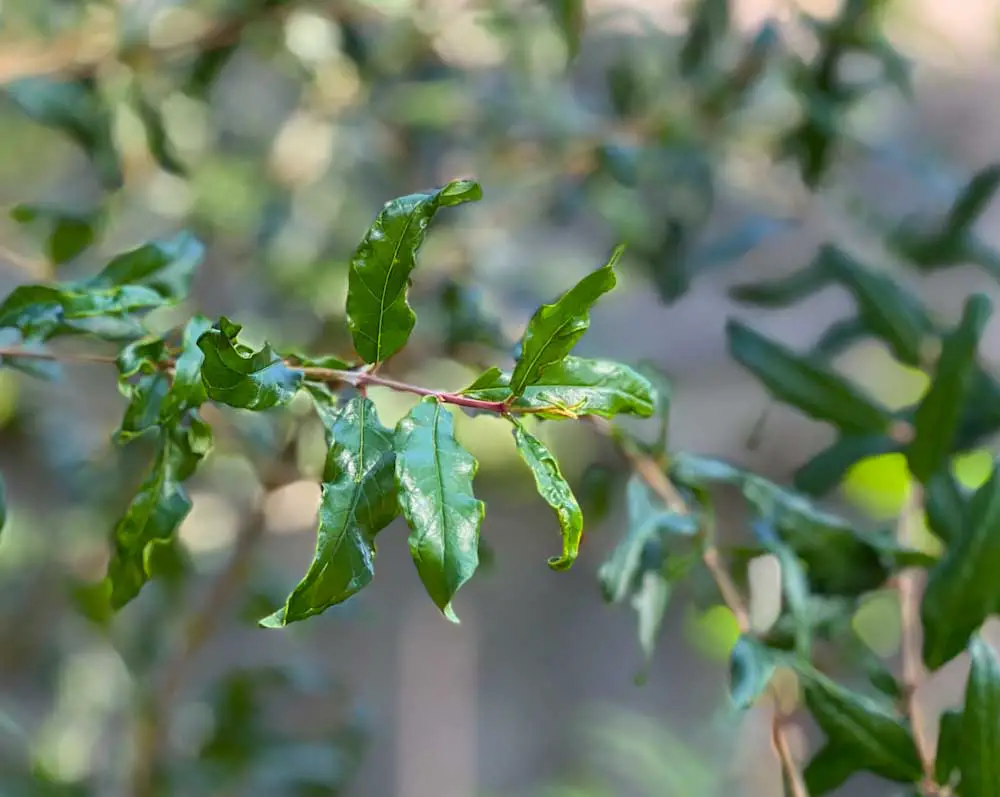
Fungal diseases are more likely to take hold in humid climates, or areas that have a rainy season. Poorly drained soil that stays saturated after a rain is the perfect breeding ground for fungal infections to grow. Prune the tree to allow for good airflow, and water when the first few inches of soil are dry.
Applying neem oil spray will help control a mealybug infestation (and other pests). Spray neem oil according to package directions in the early morning or evening. Avoid spraying when flowers are open, so no pollinators are harmed.
10. Tree Age
It takes a few years for a young pomegranate tree to begin producing flowers and fruit. Once planted, the tree’s first job is to establish a good, strong root system that will later support a large crop of developing fruit. Some growers even pluck off any blooms in the first few seasons to conserve the tree’s energy.
Once a pomegranate tree is a little more mature, it will begin setting fruit. The first crop of pomegranates will probably be small (in number and in size), but the fruit quality and quantity will improve every year. By year 5, it should be producing a reliable harvest.
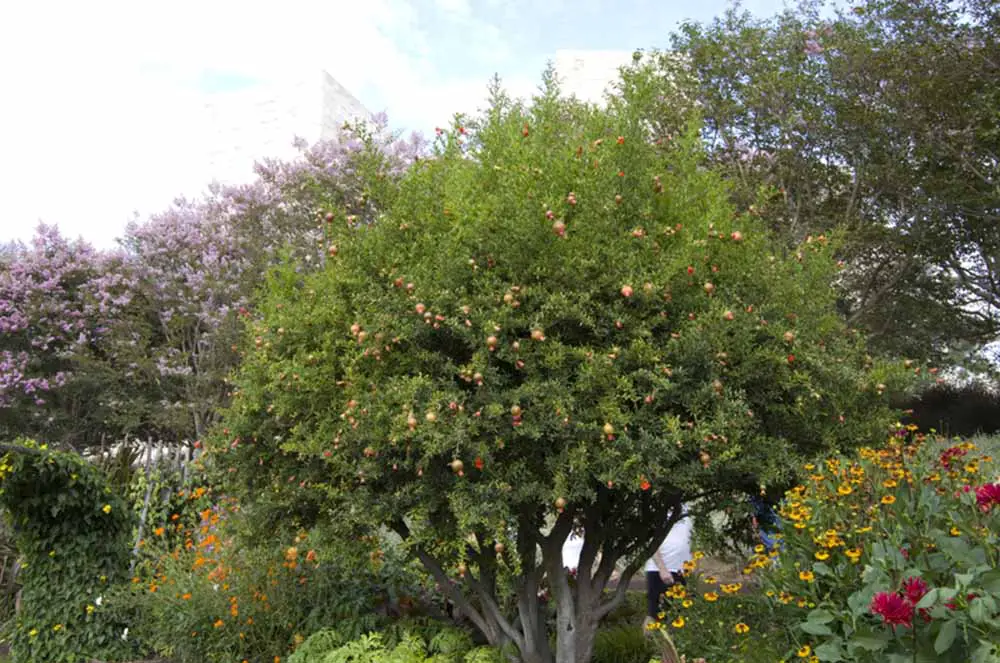
Eventually, as the tree ages, its production will begin to slow down. A pomegranate tree that’s been fruiting for 25 years or more won’t be as vigorous as it once was. The quality of fruit will decrease year after, and eventually it will no longer produce any fruit.
Learn more: The Lifespan of a Pomegranate Tree (Decades of Fruit!)
What to Do About It:
If your tree is young – wait! This was one of my beginner mistakes. My first pomegranate tree grew like crazy its first season (at least 3 feet over the course of the year), but I was impatient for actual pomegranates. A little patience paid off, and the very next year I got the first small crop. It wasn’t long before I had more pomegranates than I knew what to do with.
If your tree is old, it might be time to replace it. It’s difficult to tell exactly how old a pomegranate tree is, but if it’s very large and no longer fruiting, it’s probably past its prime.

